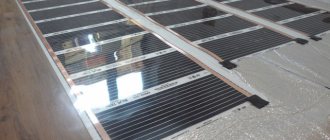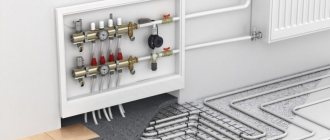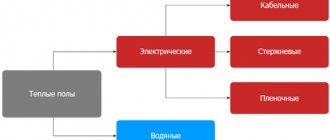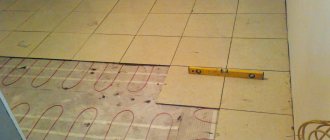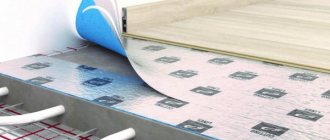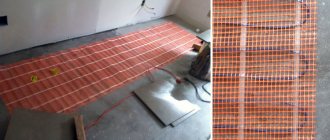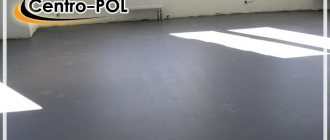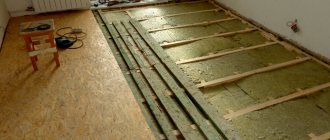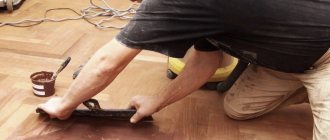Increasingly, owners in their homes prefer not to standard batteries, but to install a “warm floor” system. It consists of a number of elements, but the main one is the distribution comb; without it, the structure will not be able to function properly and maintain a comfortable temperature level.
After reading our article, you will learn about the types of collectors, their structure and operating principle. And using this material as a guide, you can assemble and install a mixing and distribution group for heated floors yourself.
Purpose of a comb for heated floors
A heated floor comb is not an independent unit, but a set of elements included in a manifold group. He is responsible for the operation of the heating floor.
More often, a warm water floor includes several circuits that have different lengths and require different amounts of coolant. Therefore, without a distribution unit, the device will not work properly.
Without a manifold, hot water will flow directly from the boiler into the floor pipes, most of it moving into the smallest loop. As a result, the small circuit will overheat, and the large circuit will not have enough heat.
If the coolant is supplied from central heating, then its heating degree is higher than required for a heated floor. If it goes into the circuits undiluted with cooled water, then overheating is guaranteed.
To do this, you need a mixing unit, where the liquid is mixed to the desired degree.
The device allows you to adjust the amount of coolant flow into each loop and the degree of its heating. This will help ensure the required temperature level.
How to adjust the comb?
In order for the water heated floor to provide a comfortable temperature in all rooms, the distribution unit must be pre-configured. The system is regulated according to 2 parameters of the coolant:
- temperature;
- consumption.
The first parameter is set on the three-way mixing valve. This can be done manually by setting the required water temperature by turning the adjustment wheel. But more often, the circuit involves a thermostatic head with a remote sensor and a capillary tube, so the water temperature must be set on it. The sensor is tightly attached to the manifold.
Quantitative adjustment of the comb can be done either manually or automatically. By rotating the cap on the valve of each circuit and looking at the flow meter readings, you should achieve the calculated water flow, if you know it. If not, then you will have to adjust it by feel within a few days.
Automatic adjustment involves replacing the caps of special servo drives that remotely interact with thermostats in all rooms. Then the comb with the pump will supply as much coolant to the heating circuits as is needed at the moment. Servo drives on all taps will control the flows at the command of the thermostats.
Device
A comb for a water heated floor consists of two horizontal pipes - supply and return, with bends for connecting the floor branches. Coolant is supplied from the ends.
To adjust the amount of liquid entering the loops, there are valves on one pipe. The comb can be adjusted manually or automatically using servo drives. To control the volume of coolant, there are flow meter flasks at the outlets of the second collector.
Heated floor comb is:
- supply and discharge pipes;
- shut-off valve at the inlet and outlet;
- fasteners for assembly;
- thermostat;
- coolant drain valve;
- air bleed valve;
- valve for supplying water from a source;
- mixing unit;
- pump.
The collector is fastened to the wall using metal brackets.
Heating circuit control
With high-quality temperature control of the coolant, its flow rate remains unchanged unless additional automation equipment is installed. Without them, the volume of water passing through the circuit is adjusted only manually - by valves and rotameters located on the supply/return manifold. But thermal valves can also be controlled automatically if you install servos on them.
Servo drives are attached to thermostatic valves on the return manifold and control them at the command of the controller
The system works like this: in the rooms there are wired or wireless thermostats that monitor the air temperature and are connected to a single control unit (controller). Receiving signals from room thermostats, it opens and closes the valves on the heated floor comb using servo drives. In this way, the controller can control underfloor heating and the radiator system simultaneously, as shown in the diagram:
In addition to temperature regulation together with thermostats, the controller can do a number of interesting things:
- respond to changes in weather conditions outside;
- preheat the required premises by a given time;
- turn off underfloor heating in unused rooms;
- controlled remotely via GSM connection or the Internet.
The use of servo drives and automation equipment not only increases the comfort for residents, but also allows you to save 15-20% of the money spent on energy costs and thus reduce the cost of heating a private home.
Operating principle of two-way valve
When using a connection diagram for a comb with a two-way valve for a heating floor, the design is equipped with a temperature sensor, it is located on the return line. The valve can be in an open or closed position, it depends on the rod that is controlled by the thermal head.
The operating principle of the device is determined by the opening of the valve, resulting in the flow of heated liquid from the boiler into the comb.
There it is diluted with cooled coolant, and then sent to the supply pipe. At this moment, the thermometer measures the temperature level of the liquid; if it is lower than required, the rod remains open.
When the desired temperature is reached, it closes and hot water stops flowing. When the coolant cools down in the heated floor, the thermal head raises the rod, thereby opening and resuming the supply.
The two-way valve is reliable, the possibility of breakage of the shut-off element is almost zero, so the risk of an excess portion of heated liquid entering the heated floor is minimal. However, it is worth saying that the control process - smoothness and accuracy - is inferior to three-way valves.
A manifold with a two-way valve can heat a room with a limited area - no more than 200 m2. The device is not suitable for heating large rooms.
Conclusions and recommendations
Judging by the reviews on the forums, homeowners are familiar with combs equipped with a mixing unit and a pump. It is noteworthy that not all craftsmen know about the existence of RTL-type thermal heads. And they can significantly reduce the price of a heated floor comb installed in a small or medium-sized country house (up to 250 m²). Here are the recommendations:
- If possible, use a factory or homemade comb with RTL thermal heads, then you won’t have to buy a circulation pump and valves. The main condition is that the length of the contours is no more than 60 m.
- If the number of loops reaches 10 or more, and the supply line from the boiler is quite long, select a more powerful main pump. You can install the Grundfos Alfa-2 15-60 unit with the Autoadapt function to save electricity.
- For circuit lengths up to 100 m, house area over 250 m² and a complex heating system, use a comb with a two- or three-way valve (quality control).
- If possible, equip the comb and underfloor heating system with automation. To do this, it is recommended to consult with a specialist in this field.
Note. Designers and manufacturers of components for heated floors categorically do not recommend making the pipe length in one loop more than 100 m (Ø16 mm).
It is advisable to avoid a situation where the distribution comb is on the 1st floor, and heated floors are installed on the 2nd and 3rd floors. It is better to place the node closer to the contours and run 2 lines to it, instead of laying 10 or 20 pipes from the comb along the walls and through the ceilings. You will get answers to many questions by watching the video:
Operating principle of three-way valve
A three-way valve differs from a two-way valve by having three outlets instead of two. One is connected to the supply tap, the other to the outgoing collector, the third to the return with cooled water.
Let's look at how the comb works:
- At the beginning, the mixing unit is closed, the supply valve from the heat source is open. The heated coolant enters the collector.
- Sensor - when the temperature rises, it gives a signal. The rod in the shut-off valve moves, which partially closes the heated water supply and opens the mixing line. The cooled coolant is mixed into the heated coolant.
- The water temperature level has returned to normal - the valve remains in this position.
- After passing through the loops several times, the liquid cools below normal, and the sensor informs about this. The mixing line is closed, the hot water supply is fully opened, and the cycle is repeated.
The coolant is mixed not in the comb, as with a two-way device, but in the valve itself.
This scheme is more accurate, and the adjustment process is much smoother. It is capable of heating a large room - from 150 m2, but the element is less reliable and often fails. In this case, there may be excessive flow of hot coolant into the pipeline, which will lead to its damage.
Installation diagram
The distribution manifold consists of two parts. The first part receives heated process water coming from the boiler, and the second part receives the already cooled coolant, that is, the return flow.
- All parts that make up the comb are connected using high-temperature treatment with a special soldering iron for plastic pipes.
- An automatic air vent and a safety group are connected to one part of the collector.
- A tap is connected for emergency drainage of water.
- A tap and an air vent are placed on the second part of the manifold. Pipes will be connected here to return the cooled coolant.
- A circulation pump is connected to the return line, which creates pressure and the coolant begins to forcefully move through the pipes and heating circuits. It is mounted approximately to the boiler, that is, the arrow on the pump should be directed towards the boiler. This installation will allow the device to last much longer.
Manufacturing companies
Different countries and companies are producing such devices. The highest quality devices are from European manufacturers, but their prices are very high - from $1000 to $1200. Products from a Chinese manufacturer are inexpensive, but they are not durable. However, there are companies that produce high-quality models at low prices.
List of manufacturers of combs for heated floors that you need to pay attention to when choosing a distribution unit:
- Millennium is a Chinese-made comb that is functional and affordable.
- TIM (China) - manifold with flow meters for water floors. A high-quality, reliable product produced using European-class equipment.
- Oventrop Multidis is a stainless steel distribution structure with forced circulation and has a long service life. Country of origin: Germany.
- Stout is an Italian-made device with flow meters. Reliable, made of quality material.
- Valtec (Italy) - nickel-brass manifold. At the outlet, the comb is equipped with taps to control the coolant flow.
Optimal temperature parameters
The preferred temperature of the heated floor is selected according to individual needs. After all, some people like invigorating freshness in the house, while others want to bask in the warming energy flows. However, there are generally accepted standards for the preparation of coolant, heating of floor coverings and, accordingly, indoor air. They are determined by sanitary and technological requirements. These standards have already been mentioned here, however, let us briefly recall:
- The optimal floor surface temperature is 28 0 C;
- if the room is designed for a long stay of residents or there are other heating sources, then it is advisable to reduce the temperature to 22-26 0 C - this energy regime is optimal from a medical point of view. In addition, heating of the coatings is unnoticeable upon bodily contact with them, which does not cause tactile discomfort;
- for rooms where the heat supply is the only source of heating, and also where residents are present only periodically (bathroom, toilet, hallway, loggia, covered veranda), the surface temperature of the floor covering can be raised to 32 0 C.
Comb selection
When choosing a comb, you need to know the need for its functionality and performance; it must have a reserve so that it can withstand sudden changes in pressure.
In addition, you need to consider:
- Material: Available in brass, plastic and stainless steel. The budget comb is made of plastic, but it is not durable. A welded stainless steel product is durable, but susceptible to corrosion. Brass manifolds are the highest quality and most reliable, but they are expensive.
- The number of valves for connecting the floor circuits - it is better to install a comb with a number of outlets equal to the floor branches. If there are more taps, then the extra ones will have to be plugged.
- Level of automation - There is now equipment that connects to thermostats and programmable controllers. They simplify the process of adjusting and monitoring temperature and coolant flow.
When purchasing a distribution unit, it is better to take a product from a well-known company, even if its price is higher - it will pay for itself during operation. Availability of appropriate warranty documentation for the product is mandatory.
Distributor made of metal fittings
If you use metal fittings instead of polypropylene, you will be able to slightly reduce the size of the structure and do without a soldering iron. But here another pitfall awaits you in the form of cheap thin-walled tees, which are scary to handle with a pipe wrench - low-quality material can crack. If you buy high-quality fittings, then the total price of the product will be closer to the factory manifold, although the savings will still remain.
For manufacturing, you need to select internal/external thread tees made of good brass, shown in the photo, and ball valves with a low stem and a butterfly handle. The same radiator valves will go to the second part of the comb. The assembly technology is simple: pack the threads with flax or thread and twist the fittings together, and then install the taps and other parts.
Advice. When assembling, try to direct all the side bends in one direction, as well as the valve stems, so that the homemade manifold looks presentable. When screwing on pipeline fittings, remove the handles and adjusting caps so that they do not cling to adjacent taps.
Installing flow meters on a comb of brass fittings is a difficult issue. Then the supply line will have to be assembled from crosspieces and special adapters for rotameters will be installed. Some of them are also made for Eurocone, so the adapter will have to be machined. It is easier to balance the system without flow meters.
As you can see in the photo, there is nowhere to put the rotameter here
Review of popular servo drive models
Servo drives for water heated floors are produced by different manufacturers. Each model has its own characteristics.
Servo drive for heating
VALTEC
VALTEC is a manufacturer of devices for water and heating supply for the home. A group of Russian and Italian specialists is working together to create products. VALTEC produces the following drives to regulate the operation of a floor-type heating system:
Combined heating system VALTEC
- TE3042.A. Belongs to the group of normally open. Designed to control valves of climate systems using commands that will be set by a thermostat, controller or manual switch. Device power – 2 W, conductor cross-section – 0.75 sq. mm. The connecting size is M30x1.5;
- TE3061.0. This is a normally closed electrothermal device. Designed for three-way valves. The operation of the device is possible due to the thermal expansion of the liquid - toluene. Drive power – 2 W, conductor cross-section – 0.22 sq. mm;
- TE3041A.0. The device works thanks to the presence of liquid in the body, which expands under the influence of temperature. Belongs to the group of normally open. Connection to the valve occurs through an adapter, which is included in the kit. Unit power – 1.8 W, conductor cross-section – 0.75 sq. mm.
Watts
Watts is the world's leading manufacturer of heating equipment of various formats. It is distinguished by high quality, affordable price and efficiency. Servo drives from Watts are models with an electromagnetic motor. Popular series:
Technical Specifications of WATTS Electrothermal Servo Drive
- 22C. It is installed on the return pipeline valve and regulates the flow of coolant into the underfloor heating system. Power is 2.5 W. Depending on the model, the 22C series includes normally open and closed devices. Protection class – IP44;
- 22СХ. They belong to electrothermal devices to ensure the efficient operation of water heated floors. There are normally closed and open models. The level of power consumption in normal operation is 1.8 W. The operating temperature of the liquid in the system is +110°C;
- 26LC. Electrothermal drives for the collector. There is an LED indicator on the case that indicates its operating mode. If the green light comes on, voltage is supplied to the drive, blue light means the device is open.
REHAU
Drives for adjusting the operation of water heated floors from a German manufacturer. They combine innovative developments and proven quality over the years. The most popular models from REHAU:
- UNI for 230, 24 V. The device is mounted on the valves of the manifold group using a special adapter. Applies to normally closed devices. Control over the operation of the drive is carried out through an indicator. Connecting cables with a cross section of 2x0.5 sq. mm;
- drive 230, 24 V. When de-energized, the valve is in the closed state. To control the functioning of the device, a light indicator is placed on the case.
Rehau servo drive characteristics table
LUXOR
The Italian company LUXOR specializes in the production of water shut-off valves and systems for regulating the temperature of the heating system for the home. The installed collector group will include an SM 1347 drive. It is designed to regulate the temperature of the supplied coolant for a warm water floor. Main technical characteristics of the device:
- power supply – 24 V;
- The operation of the device is provided by a stepper motor. Its control is electronic;
- there is an LED indication on the case that indicates the operating mode;
- installation takes place in a straight position - vertical or horizontal;
- maximum temperature in the system – +100°C;
- cable 1.5 m long;
- device storage temperature – from 0 to +50°С;
- The body is made of synthetic materials. Its color is gray;
- Warranty available - 2 years.
Regardless of the model chosen, installation of the servo drive and its operation must be carried out in accordance with the manufacturer’s recommendations. These can be found in the instructions for the device. After installing the drive and all system elements, they begin to use them after full testing.
Manufacturing materials
The reliability and durability of the collector directly depends on the material from which it is made. A comb for heated floors can be metal or polymer. Each option has its own advantages and disadvantages.
Polypropylene
A manifold made of polypropylene pipe is an extremely economical option. In addition to the affordable price, one can note the light weight of the device. Models with fittings and combs with shut-off ball valves are available for sale. To connect metal products, combined fittings are used.
The disadvantages of polypropylene collectors include:
- thick walls, due to which the passage cross-section is smaller than that of metal combs of the same size;
- less strength and durability compared to metal models;
- oxygen permeability - even if polypropylene is reinforced with fiberglass reinforcement, there is diffusion of oxygen, which provokes corrosion of steel elements of the heating system and boiler.
Collector block made of polypropyleneSource chudopol.ru
The list of advantages of polymer combs includes:
- resistance to aggressive environments (antifreeze can be used as a coolant);
- resistance to electrochemical corrosion;
- low heat loss compared to metal products.
You can buy a polypropylene heating manifold or make it yourself from a pipe of a suitable size and fittings.
Brass
Brass is a classic material for the manufacture of heating manifolds. The comb is made using the stamping method or holes are drilled for bends and threads are cut on sections of a hollow brass rod.
Collectors made of this material have one drawback - zinc is washed out of the metal. Therefore, it is recommended to use nickel or chrome plated products. These combs:
- durable;
- resistant to corrosion and aggressive environments.
The disadvantage of brass manifolds is their high price. You can also note the smaller flow area compared to steel models.
Brass manifoldSource prom.st
Stainless steel
Stainless steel collectors are in demand due to the combination of high performance parameters and affordable prices. The advantages include:
- large flow area, making it easier to balance the underfloor heating system;
- mechanical strength even in the presence of a weld;
- resistance to corrosion and aggressive environments;
- durability.
A heating comb of a reputable brand (for example, VALTEC), made of high-quality stainless steel, is designed for 30-50 or more years of operation. Cheap products from unknown manufacturers, including counterfeits, are often made of low-quality steel and are susceptible to corrosion.
Stainless steel manifoldSource termo-snab.ru
Briefly about the main thing
The equipment of the collector block must meet the requirements for the functionality of the system. The collector device ensures uniform heating of the heating elements and a constant temperature in the room. Made from the following materials: polypropylene, brass and steel.
The manifold consists of a system to which threaded elements, fittings or control valves are connected. The collector is installed in a special cabinet or brackets are used.
Along with it, a mixing unit is used.
The durability of combs directly depends on the material and workmanship. You can purchase a ready-made distribution block or assemble it yourself from individual elements.
| Additionally The exhibition of houses “Low-Rise Country” expresses sincere gratitude to the specialists for their assistance in creating the material. – supplier of water supply and heat supply systems for any facilities, from the world's leading brands. The company also develops and installs automated metering systems for energy consumption. If you need more detailed advice, you can use the following contacts: |
Operating principle of the mechanism
A very simplified description of how a comb for a heated floor works is as follows: an input-output unit with control of the flow rate, pressure, volume and temperature of the energy carrier.
Stage-by-stage movement of water in a comfortable water floor system:
- From the boiler or from the central heating system, water flows to the supply valve element of the comb assembly for the heated floor. Here the mixing of cold and hot water occurs, the height of the inlet damper is adjusted;
- under the influence of the pump, water moves into the supply manifold. Due to the difference in the lengths of the circuits, the amount of water supplied to them is also different. Flow meters are installed on the pipes. If at this stage you use a servo drive connected to a temperature sensor in the process, you can automate the process of supplying water when the floor cools below the set temperature;
- During processing, water is removed from the system through the outlet manifold. To control the pressure level in the system, a valve is installed here, which should operate automatically if the value is excessive.
Principles of technology for connecting to finished heating
Connecting a heated floor to an existing heating system requires compliance with the following principles:
- each radiator will need to additionally connect a collector unit;
- the coolant should not have a temperature of more than +55 degrees;
- the new design should not have a standard pressure of more than 9 atm.
During preparation, it is necessary to calculate the operating parameters of the heated floor, depending on the existing heating system. It can be one- or two-pipe.
In a two-pipe system, there are two separate pipes. In one way, hot liquid is supplied, and in the other, cooled liquid is discharged to the boiler. In a one-pipe system, the coolant circulates through one pipeline. In this case, the warm floor will be connected as an additional radiator. It is mounted after the heating device, which eliminates the use of devices to reduce the temperature of the coolant.
It is impossible to obtain effective operation of a heated floor using the gravitational principle of fluid movement. The transition of coolant from a pipe of a larger diameter to a smaller one is impossible, since hydraulic resistance arises.
